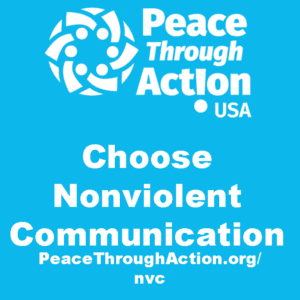What is Nonviolent Communication?
Nonviolent Communication is a method of communicating that focuses on listening, processing, and working towards meeting the needs of both parties involved in a conversation. Nonviolent Communication (NVC) is based on the premise that “[u]nderlying all human actions are needs that people are seeking to meet, and [that] understanding and acknowledging these needs can create a shared basis for connection, cooperation, and more globally – peace.”[1]
The publisher of Nonviolent Communication describes it this way: “The purpose of Nonviolent Communication is to help all involved to sharpen their awareness of language so that they can express what really matters to them and hear what really matters to others. It involves empathic communication whereby we can attune ourselves to both our own and other people’s real needs.”[2]
Nonviolent Communication can be broken down into four components: observation without judgement; taking responsibility for your feelings; connecting these feelings to unmet needs; and making actionable requests.
The originator of Nonviolent Communication is Marshall Rosenberg, PhD, who introduced the method in 1972 in a training manual. Rosenberg envisioned this method of compassionate communication to resolve disputes between people, whether they be in a small community or international politics.[3]
[1] Kashtan, I., Kashtan, M. (n.d.). Basics of nonviolent communication. Retrieved on June 28, 2022, from: https://baynvc.org/basics-of-nonviolent-communication
[2] Rosenberg, – M. B. (2020, August 11). Learn nonviolent communication. PuddleDancer Press. Retrieved June 29, 2022, from https://www.nonviolentcommunication.com/learn-nonviolent-communication/
[3] Ibid
How do people learn Nonviolent Communication?
The Center for Nonviolent Communication (CNVC), founded by Marshall Rosenberg, PhD., facilitates training of this practice. Not only does CNVC host training, it also sends trainers around the world to teach the method.
There are several organizations in the US and across the globe that have been trained by the Center for Nonviolent Communication and then offer their own training for individuals and groups that want to use NVC in their daily lives. Training can be done in person or virtually and then shared further with one’s organization or community.
The resource list below includes links to NVC training organizations as well as to worksheets and exercises to practice the method.
How do people implement Nonviolent Communication?
Nonviolent Communication can be implemented individually by one putting into practice the methods and skills in daily life. There are many NVC practice groups established for people trained in NVC to maintain their competence with their peers.
Nonviolent Communication can be implemented in an organization setting. Organizations can retain trainers to teach NVC to their employees and then create policies and practices that facilitate their use of NVC skills.
For what types of circumstances is Nonviolent Communication suited?
Nonviolent Communication is well suited for developing positive social and emotional behaviors among people who use it. Also, it is well suited for interrupting aggression and violence between people and groups.
Does Nonviolent Communication work for preventing or controlling aggression or violence?
Nonviolent communication reduces conflict by helping people connect to their needs and build their emotional vocabulary. Also, it teaches people to hear or see the needs behind the behaviors of themselves and others. It allows people to discover the heart of a conflict faster.[1] By focusing on needs instead of the behaviors themselves “without interpreting or conveying criticism, blame, or demands, our deeper creativity flourishes, and solutions arise that were previously blocked from our awareness. At this depth, conflicts and misunderstandings can be resolved with greater ease.”[2]
[1] Center for Nonviolent Communication (May 2018). Key facts about nonviolent communication (NVC) Puddle Dancer Press. Retrieved on June 28, 2022, from: https://www.nonviolentcommunication.com/pdf_files/key_facts_nvc.pdf
[2] Kashtan, I., Kashtan, M. (n.d.). Basics of nonviolent communication. Retrieved on June 28, 2022, from: https://baynvc.org/basics-of-nonviolent-communication
Where else might I go to learn more about Nonviolent Communication?
- This article from Positive Psychology gives an in-depth description of Nonviolent Communication and provides worksheets, exercises, and games to help learn the skills and put them into practice.
- The Center for Nonviolent Communication provides training and resources for learning and implementing nonviolent communication. It is also continuing to study the effects and benefits of the use of nonviolent communication around the world.
- The NVC Academy ensures the accessibility of Nonviolent Communication training to individuals worldwide, regardless of the availability of trainers in their immediate geographic region and financial situation.
- Peace Through Action’s Nonviolent Communication learning event.
Information Sheet-Choose-Nonviolent Communication (PDF)
Page Author: Amy Neal (volunteer)
Have a suggested improvement to this information sheet? Send it to inbox@peacethroughaction.org
Do Something Right Away to Increase Peace
Subscribe to our YouTube channel
Give a gift of money to support our mission delivery activities
Choose opportunities to take part in our #PeaceBeginsWithWe campaign

